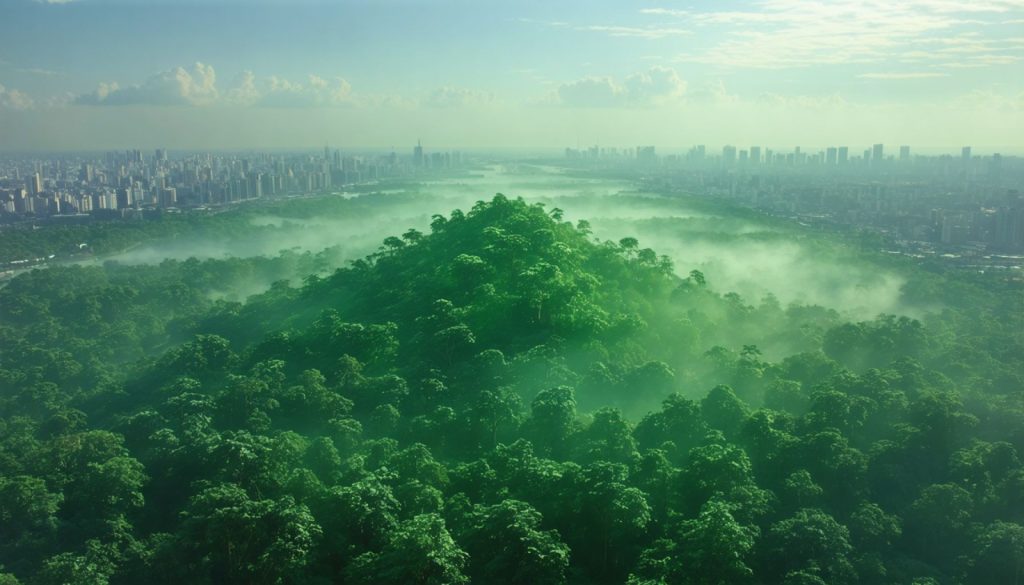
- Cities worldwide are integrating nature into urban landscapes, transforming conventional urban living.
- Innovative green spaces, such as rooftop and vertical gardens, and parks, are emerging in urban areas.
- Biophilic design is central to this movement, enhancing mental health and well-being by reconnecting people with nature.
- These initiatives boost biodiversity, inviting a variety of species back to cities and enriching urban ecosystems.
- The approach serves as a model for sustainability, advocating for harmonious coexistence between urban development and nature.
Amidst the concrete jungle, where skyscrapers loom large and the horizon seems almost to quiver under a glass-and-steel skyline, something profoundly transformative is taking root. Cities across the globe are shifting their focus from relentless expansion to sustainable cohabitation with nature, carving out verdant refuges that defy the traditional image of urban living.
Vibrant green spaces are sprouting in unexpected places—on rooftops and vertical gardens, in sprawling parks nestled between bustling highways, and even along the neglected banks of once-forgotten rivers. These urban oases are not mere decorative flourishes; they are the lifelines of a new ecological reality. In places like Barcelona, New York, and Singapore, city planners are integrating nature into the urban fabric with intention and creativity, fostering ecosystems that enrich the lives of city dwellers.
The driving force behind this green revolution lies in biophilic design—a revolutionary approach which advocates for reconnecting people with their natural environment. Research underscores that such environments bolster mental health, reduce stress, and improve overall well-being. As these green initiatives unfold, they offer a fresh, verdant balm to the frenzied pace of metropolitan living, enhancing the quality of life in ways both subtle and profound.
Yet, the allure of these urban gardens is not just in their beauty. Plants bloom and thrive in places once dominated by smog and asphalt, sending ripples through ecosystems and encouraging biodiversity in species that had long vanished from city centers. This resurgence turns once sterile concrete corridors into vibrant habitats, buzzing with life and activity—birds, bees, butterflies—all bringing their gentle symphonies to the urban soundscape.
As cities evolve, a rich mosaic of greenery promises not just an aesthetic transformation, but a revolution in how humans interact with their surroundings. In nurturing these spaces, we are reminded of our intrinsic connection to the Earth, and the vital importance of preserving that link for future generations.
The key takeaway is a clarion call for urban centers worldwide: Embrace the green, nurture our nature, and redefine what it means to coexist harmoniously with the world around us. In doing so, cities not only transform their landscapes but also offer a blueprint for a sustainable future—a future where nature and humanity flourish side by side.
How Urban Green Spaces Are Shaping the Cities of the Future
Integrating Green Spaces: A New Urban Reality
The global shift towards sustainable urban development is more than a trend—it’s an essential transformation. As urban centers begin to incorporate nature into their cores, these green spaces are proving to be vital components of modern city life. Not only do they offer visual beauty, but they also bring ecological and psychological benefits that redefine the way we live in cities.
Benefits of Biophilic Design
1. Improved Mental Health: Biophilic environments have been shown to reduce stress and anxiety. According to a study published by the Journal of Environmental Psychology, exposure to natural elements can significantly increase emotional well-being and cognitive function.
2. Enhanced Biodiversity: Urban green initiatives boost biodiversity by providing habitats for various species. Urban areas in cities like Singapore now support diverse flora and fauna, encouraging a thriving ecosystem.
3. Reduced Urban Heat: Green roofs and vertical gardens can mitigate the urban heat island effect by cooling the air, leading to more comfortable living environments. According to the EPA, rooftop gardens can decrease rooftop temperatures by 30-40%.
How-To: Creating Your Own Urban Oasis
– Rooftop Gardens: Utilize available space to create a garden by selecting plants that thrive in your climate zone. Ensure proper drainage and use lightweight soil mixes.
– Vertical Gardens: Perfect for small spaces, vertical gardens can be installed on walls using pockets or trellises. Select shade-tolerant plants like ferns or succulents depending on sunlight availability.
Market Forecast & Industry Trends
The urban greening market is projected to grow significantly. According to a report by MarketWatch, the green building market is expected to reach $412 billion by 2027, highlighting the demand for sustainable urban solutions.
Controversies & Limitations
While urban greening offers many benefits, it is not without controversy. The gentrification of urban areas can lead to increased property values, pushing out lower-income residents. It’s crucial for city planners to implement inclusive greening strategies that benefit all citizens.
Actionable Recommendations
– Support Local Initiatives: Engage with local community gardens or support NGOs focused on urban greening efforts.
– Advocate for Green Policies: Encourage local government officials to incorporate green spaces in urban planning.
– Personal Greening Projects: Even small efforts like balcony planters or window boxes can contribute to urban greenery.
Conclusion: Embrace the Future
The future of urban living hinges on our ability to integrate green spaces into everyday environments. Cities around the world, from New York to Singapore, are showing us that with thoughtful design and planning, we can create harmonious, sustainable urban ecosystems.
To stay informed on sustainable urban living and green innovations, visit Nature Conservancy.
By embracing nature in our cityscapes, we foster a future where both humans and the environment thrive.



